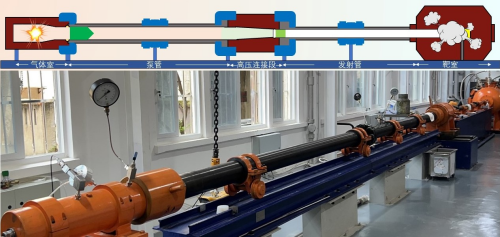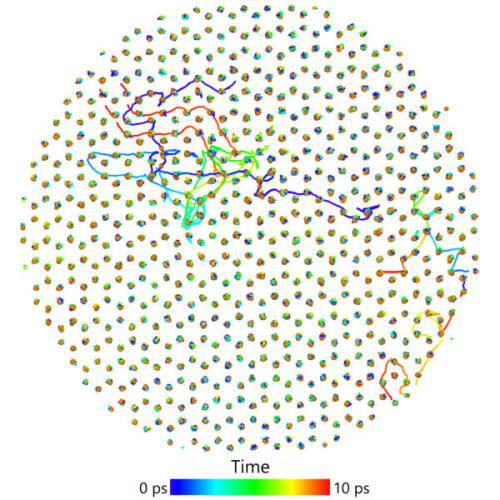In collaborating with researchers of Nanjing University, the Institute of Physics Chinese Academy of Sciences, and the University of Texas at Austin, Youjun Zhang, a research fellow from the Institute of Atomic and Molecular Physics, SCU, published a research paper titled "Collective Motion in hcp-Fe at Earth's Inner Core Conditions" in the Proceedings of National Academy of Sciences (Proc. Natl. Acad. Sci.). Being published on Oct. 2, 2023, the paper discussed the wave velocity changes and micro dynamic mechanisms of the Earth's component solid iron (Fe) under extreme high temperature and pressure conditions, and unveiled the physical mechanism of shear softening in the solid core, achieving important breakthroughs in the fields of deep Earth science and Earth's internal physics.

Figure 1. Instantaneous simulation of core temperature and pressure during high-speed impact of a two-stage light gas gun at the Institute of Atomic and Molecular Physics, Sichuan University
“Earth’s inner core is predominantly composed of solid iron (Fe) and displays intriguing properties such as strong shear softening and an ultrahigh Poisson’s ratio. Insofar, physical mechanisms to explain these features coherently remain highly debated. Here, we have studied longitudinal and shear wave velocities of hcp-Fe (hexagonal close-packed iron) at relevant pressure–temperature conditions of the inner core using in situ shock experiments and machine learning molecular dynamics (MLMD) simulations. Our results demonstrate that the shear wave velocity of hcp-Fe along the Hugoniot in the premelting condition, defined asT/T m(T m: melting temperature of iron) above 0.96, is significantly reduced by ~30%, while Poisson’s ratio jumps to approximately 0.44. MLMD simulations at 230 to 330 GPa indicate that collective motion with fast diffusive atomic migration occurs in premelting hcp-Fe primarily along [100] or [010] crystallographic direction, contributing to its elastic softening and enhanced Poisson’s ratio. Our study reveals that hcp-Fe atoms can diffusively migrate to neighboring positions, forming open-loop and close-loop clusters in the inner core conditions. Hcp-Fe with collective motion at the inner core conditions is thus not an ideal solid previously believed. The premelting hcp-Fe with collective motion behaves like an extremely soft solid with an ultralow shear modulus and an ultrahigh Poisson’s ratio that are consistent with seismic observations of the region. Our findings indicate that premelting hcp-Fe with fast diffusive motion represents the underlying physical mechanism to help explain the unique seismic and geodynamic features of the inner core.” (Abstract)

Figure 2. Movement model of iron atoms under 10 picoseconds of temperature and pressure in the Earth's core
Proc. Natl. Acad. Sci. published the research paper on Oct 2, 2023. The Institute of Atomic and Molecular Physics of Sichuan University is the first work unit, and Youjun Zhang is the first author. The main collaborators include Professor Jian Sun and Dr. Yong Wang from Nanjing University, Jun Li from the Chinese Academy of Sciences, and Professor Junfu Lin from the University of Texas at Austin.The above work has received support from the National Natural Science Foundation of China, the Sichuan Provincial Natural Science Foundation of China, and the Sichuan University Youth Program.
The research team of Youjun Zhang is mainly engaged in the internal physics of the Earth and planets, as well as the physics of extreme conditions. The team has set up a dynamic high-pressure experimental platform and a shock wave physics and geophysics research laboratory at the Institute of Atomic and Molecular Physics. In recent years, Youjun Zhang has published over 40 papers in his capacity of the first author or corresponding author in top notch academic journals such as Science, Proc. Natl. Acad. Sci. U. S.A., Phys. Rev. Lett., Sci. Bull., Earth Planet. Sci. Lett., Geophys. Res. Lett, Phys. Rev. B and J. Geophys. Res. and so forth.
http://www.pnas.org/doi/10.1073/pnas.2309952120
